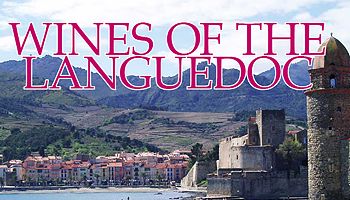WINES OF THE LANGUEDOC
The Languedoc seems to me a land of opposing extremes: ancient and ultramodern, enormous yet unimposing, placidly rural despite a roiled history. One finds rustic wines from obscure traditional grapes alongside state-of-the-art, high-tech, Parker-pleasing products of international varieties.
The Languedoc was one of the earliest wine-producing regions in France: visited by the Phoenicians, viticulture established by the Greeks well before the Common Era, and cultivated by the Romans. It gets its name from the medieval language (langue) of Occitan used in southern France, in which “yes” was “oc”. [Oui evolved as “yes” in the north.] The wines have evolved. Once largely distilled into industrial alcohol, then, and even still, a major contributor to the European “wine lake” of excess production sustained by substantial EU subsidies, the region is in a ferment of modernization – undergoing transformation to the twenty-first century. Despite 3O years of decreases, particularly of the lower categories, it is France’s, and the world’s, largest producer. The climate, the terroirs, and the old habits persist in large measure, so individual selection is necessary. Many wines, which are mostly red, taste the same: simple, flabby, grapy, and dilute. But one’s efforts can be rewarded by distinctive and characterful wines, often at attractive prices. While the growing excitement of a few years ago was not, in my opinion, consummated, continued self-discipline and realistic austerity may yet lead to the region’s gaining international respect.
The Languedoc occupies an arc on the Mediterranean and the uplands behind, from west of the Rhône to the border of Rousillon, part of what used to be called the Midi. It contains 725,OOO acres of vines. The number of growers has decreased to 15O,OOO. More than 2OOO vintners produce 177 million cases of wine annually. Only ten percent is composed of the 3O AOCs. The region is warm and sunny. It gets little rain. Winds are almost constant; the most influential are the cool and dry Tramontane from the northwest and the helpfully humid Marin from the southeast. Soils vary. The indigenous scrub vegetation, the garrigue, is thought to imprint itself upon the wines.
Traditional high-yield carignon, cinsault and aramon are giving way to the more distinctive red varieties of the southern Rhône: syrah, grenache and mourvèdre. Cabernet sauvignon and merlot have taken hold. Red wines account for 75 to 😯 percent of production. Among the better-known appellations are Corbières, Faugères, Fitou, La Clape, Minervois, Nîmes, and Saint Chinian. Whites and rosés are less known. The host of unfamiliar white varieties are being replaced by chardonnay and sauvignon blanc, though the region may be too warm for optimal cultivation of the former. Sparkling wine has been made in Limoux since before Champagne ever bubbled, now using mauzac, chenin blanc and chardonnay. Sweet muscat-based fortified wines, misleadingly called Vins Doux Naturels, have AOCs in Frontignan, Lunel, Mireval, and Saint Jean de Minervois.
The growers and vintners of the Languedoc, many of whom work through cooperatives, have long expressed their opinions frankly. Riots in 19O7 protested importation of cheap Algerian wine. Bombings of bottling plants in 2OO9 were their comments on importation of American and Australian wines. Views have been aired by destruction of trucks carrying wine and blockage of highways. L’affaire Mondavi is illustrative. In 2OOO, Robert Mondavi proposed establishment of new vineyards and building of a new winery at Aniane, all sensitive to the character of the surroundings. After he received official approval and purchased land, prominent producers in the area and their pet politicians raised a great outcry and blocked the project. Among them, Aimé Guibert, proprietor of the esteemed (not by me) Mas de Daumas Gassac, was quoted: “. . . for me, Mondavi’s wine is nothing better than yogurt” – possibly an indication of his objectivity.
In early April, Boston enjoyed hosting the annual national tour of Languedoc’s AOC wines, affording the trade a symposium and a tasting of the wines of fourteen importers. Reflecting the region’s production, most of the wines were red. Three wines, in particular, I thought were noteworthy.
CHÂTEAU DES KARANTES 2O1O La Clape Bergerie
Primarily Grenache and Mourvèdre. The latter is evident. Well balanced, good fruit, decent finish. $15
ERMITAGE DU PIC SAINT LOUP 2OO8 Pic Saint Loup
Syrah 5O percent, Grenache 4O, Mourvèdre 1O, all low-yield fruit. Fragrant, fruity, middle-weight wine. Very pleasant indeed. $18
MINERVOIS 2OO9 Hecht & Bannier
A conventional blend of Syrah, Grenache, Carignon, Mourvèdre, and Cinsault.
This is a dark, full-bodied wine, with good fruit and finish.
The Grenache makes itself known. $18

